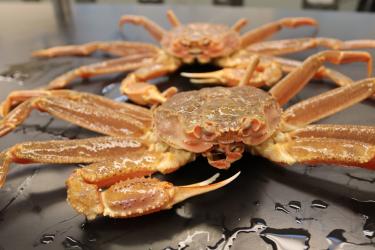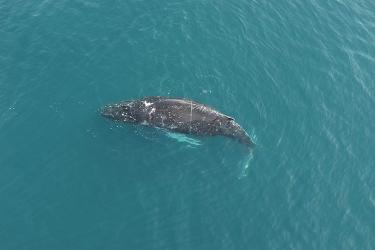Scientists are increasingly using environmental DNA to detect species in the marine environment. However, in the ocean, physical variables including temperature, depth, salinity, currents, and tides can all affect eDNA dispersal. This makes it difficult to interpret eDNA results and determine the location of animals relative to eDNA detections. In a recent study, scientists examined the influence of distance and tides on the distribution and concentration of eDNA from chum salmon in net pens in southeast Alaska.
“There have been very few studies in the marine environment that track the distance that eDNA can disperse,” said Diana Baetscher, a research geneticist at the Alaska Fisheries Science Center. “This study addresses one of the critical knowledge gaps in applying eDNA to marine fisheries management.”
Nearshore Salmon Net Pens Used to Test eDNA Dispersion and Tidal Influence
Scientists found a hatchery net pen, containing more than 46 million juvenile chum salmon in nearshore waters of southeast Alaska, was the perfect site for their experiment. Their goal was to learn how far eDNA traveled from the site and how much of a role tides played in dispersing the eDNA.
The study area in Amalga Harbor is about 24 miles north of Juneau, Alaska. It experiences large tidal swings (13.74 feet mean tidal range) and is characterized by strong currents and significant freshwater input. At this high latitude, water temperatures are cold ( less than 8° Celsius) and eDNA degradation was expected to be minimal. Previous studies have shown marine eDNA can persist in nearshore waters for up to 48 hours. Scientists expected this would be enough time for eDNA to disperse from the net pens throughout the study area.
Using a genetic analysis method known as quantitative PCR, the scientific team evaluated the effect that distance and tide had on chum salmon eDNA transport by measuring the concentration of eDNA.
“The real value of this type of eDNA analysis is that we can collect quantitative information about individual species,”said Baetscher. “Of the limited genetic studies to track eDNA in the marine environment, most have relied on DNA metabarcoding. Metabarcoding allows us to detect dozens of species at the same time, but it typically provides less precise species-specific quantitative information.”
In 2021 the scientists collected filtered surface water samples, 80 meters apart, along a 2 kilometer perpendicular line or transect that extended from the net pen into the channel. They collected samples at both outgoing and incoming tides on a single day (May 10).
The following year, Baetscher and the team sampled at three depths (0 meters, 5 meters, and 10 meters) every 500 meters along the same transect. They also sampled along a perpendicular transect, to understand dispersion by depth and in additional directions.
Environment DNA Study Findings
DNA concentrations decreased with increasing distance from the net pen and with increasing depth.
- The majority of DNA detections were within 1.5 km of the pens
- The majority of eDNA was found at the surface
Tide had a significant effect.
- Higher concentrations of chum salmon DNA were observed throughout the transect during incoming tide
- There was a steeper decline in eDNA over distance during outgoing tide
Study in the Context of Other eDNA Research
A study like this is important because it is a somewhat controlled experiment. The scientists used stationary net pens that contained thousands of chum salmon in an area where few to no other chum salmon were present because of the time of sampling (early May). They were able to focus on the role of surface distance from the pens and the tidal exchange of the ocean in dispersing eDNA.
“What we learn in controlled studies is invaluable for understanding eDNA transport, degradation and fate in complex marine environments. This includes both nearshore and offshore where many factors are at play and interacting with each other such as wind and ocean currents,” said Baetscher.
Importantly, the data from this study provide some bounds that may be useful for interpreting eDNA data for important fisheries species.
Many such species—especially in the northeast Pacific—form large schools that could represent biomass on the scale of the more than 46 million salmon in the net pen experiment. Large schools of fish will produce a strong eDNA signal. Scientists also expect that, as in this study, DNA concentration will decrease and detections will become more sporadic, and then absent, as distance increases. This will allow for comparisons between eDNA collected on fisheries surveys and collections from nets and acoustic data.
Current eDNA studies in the Alaska Fisheries Science Center’s Genetics Program are building off of this research. This includes:
- Generating eDNA data for commercial species such as walleye pollock and Pacific cod
- Studying prey species for marine mammals including northern fur seals
- Exploring rocky habitats that are not possible to sample with standard survey gear to learn more about the composition of species that live there





